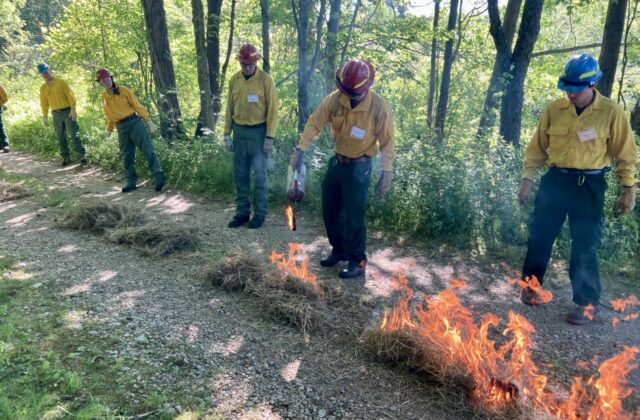Preparing in Norfolk to Fight Wildfires Across North America
Interstate fire crew trains locally at Yale Camp
By David Beers
During the first week of June, 26 students and 10 instructors were cut off from the world at Yale Camp at Great Mountain Forest for four days of wildland fire training. The instructors were seasoned wildland fire fighting veterans and the students were new recruits and returning firefighters seeking recertification for the Connecticut Interstate Fire Crew (CIFC). CIFC is an offshoot of the Connecticut Department of Energy & Environmental Protection (DEEP); one of DEEP’s areas of responsibility is forest fire prevention and control. CIFC is a team of special firefighters who are deployed across the country to help protect lives, property and natural resources threatened by wildfire. This summer’s CIFC trainees and instructors hail from all over Connecticut and Rhode Island. Yale Camp has hosted CIFC training for over a decade, providing bunkhouse lodging, meals, a ready forest and evenings around the campfire.
Yale Camp is an ideal location to focus on learning how to safely and effectively fight wildland fires. This training is an even mix of classroom instruction and forest exercises. CIFC recruits range in age from 18 to 50, with most in their 20s. While some are attending as part of their job requirements, most are there by choice and have jobs that allow them to take the time needed for both training and firefighting assignments. Some recruits have no previous firefighting experience; others have been volunteering with their local fire department for years. All are in excellent physical condition and have passed the pack test—walking three miles in 45 minutes while carrying a 45-pound pack.
A look at all that CIFC packs into its four-day syllabus shows the key concepts that are a big part of fighting wildland fires: fuels, weather, topography, fire behavior, wind, safety, risk management, suppression, first aid, incident response, available resources, hazards, communication, entrapment avoidance, decision making, incident command system, team cohesion, personal protective gear, emergency fire shelter deployment, after action review, cold trailing, griding, mop-up…it is a lot to learn.
Just like when they are mobilized for fire duty, the students are split into squads to rotate through different training units. Students always wear flame-resistant Nomex attire and use specially designed firefighting backpacks to hold all essential gear. The most vital of this is the fire shelter. They learn to properly deploy this as fast as possible for the worst-case scenario of being overtaken by a fire. It is hard to believe that a little bivy sack of aluminum foil and fiberglass can protect anyone from a wildland fire’s typical heat of 1,600 degrees Fahrenheit, but it can for a limited time. Hopefully, good planning and safety practices will mean that no one at this training will ever have to deploy their shelter in their firefighting career. If they do, it will likely save their lives.
This training week is vital to the safety of these students and all their crewmates on each firefighting mobilization; some of those crewmates may even be their current instructors. Once certified, many could soon be mobilized for two-week stints fighting wildland fires anywhere in North America. Past mobilizations have included California, Montana, Idaho, Minnesota, South Carolina, Virginia and Canada. In 2021, tens of thousands of firefighters were mobilized to fight 58,733 fires on 7,139,713 U.S. acres. This is twice the acreage of the state of Connecticut. Increasing droughts and heat are projected to make wildland firefighting more needed and more difficult as fires get hotter and bigger each year.
CIFC instructor Rachael Holmes shared experiences from some of her mobilizations. Her first, in 2012, was filled with excitement and nervous energy, she said, describing ho
w her New England crew drove in vans to Montana to join a task force of 1,000 firefighters in a temporary tent city in the middle of nowhere to fight a fire spanning thousands of forested acres. For such a large fire control effort, temporary showers and mess halls were set up. She says her mobilization last year was quite different, though. There, her crew of 20 from Connecticut flew to Minnesota and were on their own to set up tents and prepare their own food in a camper parking lot to fight a relatively small 20-acre fire. Both trips involved exhausting, long, dirty days in rough terrain, with the crews always making sure to ingest enough food (6,000 calories) and water to stay healthy.
For one week each June Norfolk is honored to host firefighting heroes as they train to help communities across the country battle wildfires. For more information on CIFC, please visit portal.ct.gov/DEEP/Forestry/Forest-Fire/Connecticut-Interstate-Fire-Crew.

